AWM137 2/1 - Historical information and general development of the RAAF Nursing Service - Notes of History of the RAAF Nursing Service 1940-1944 - Part 5
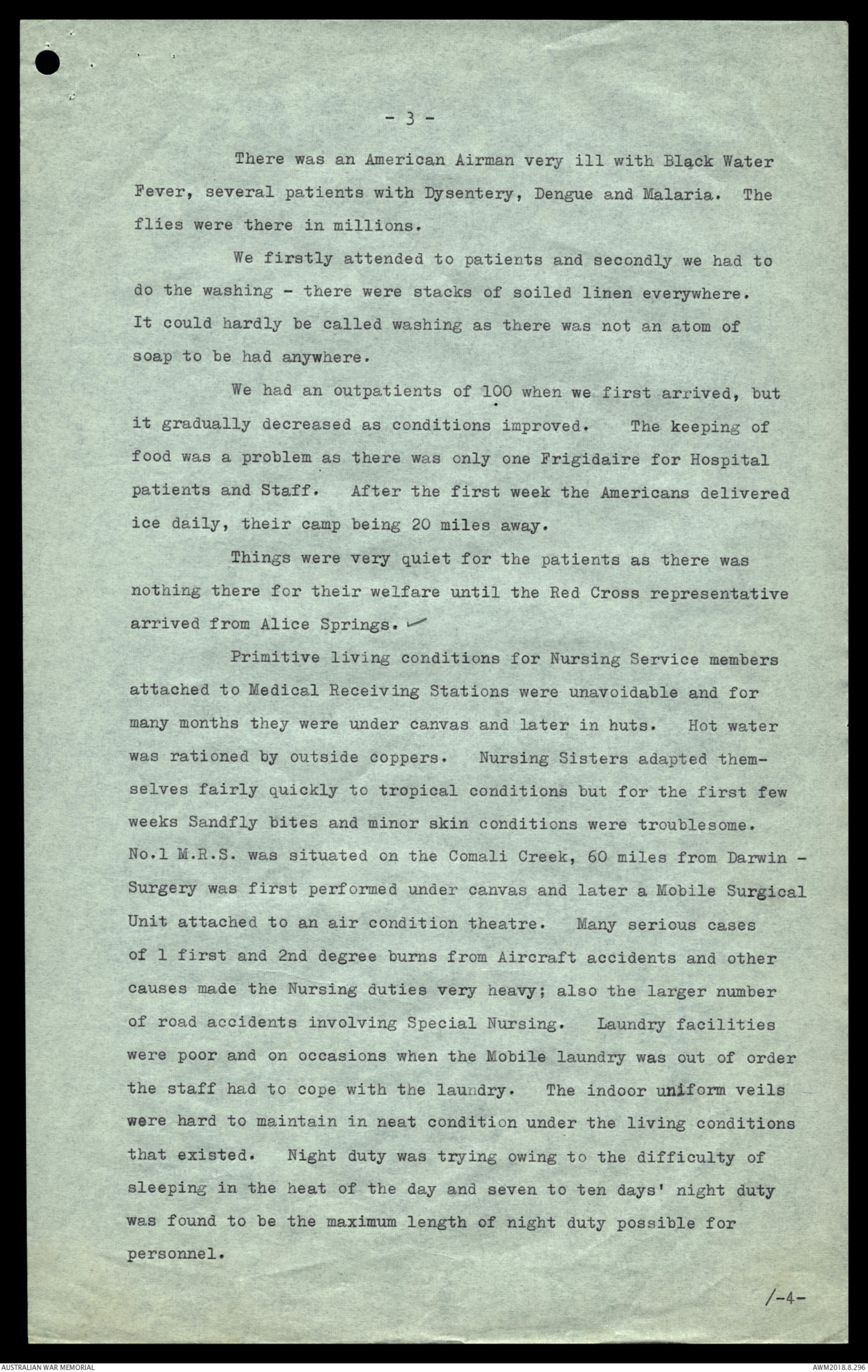

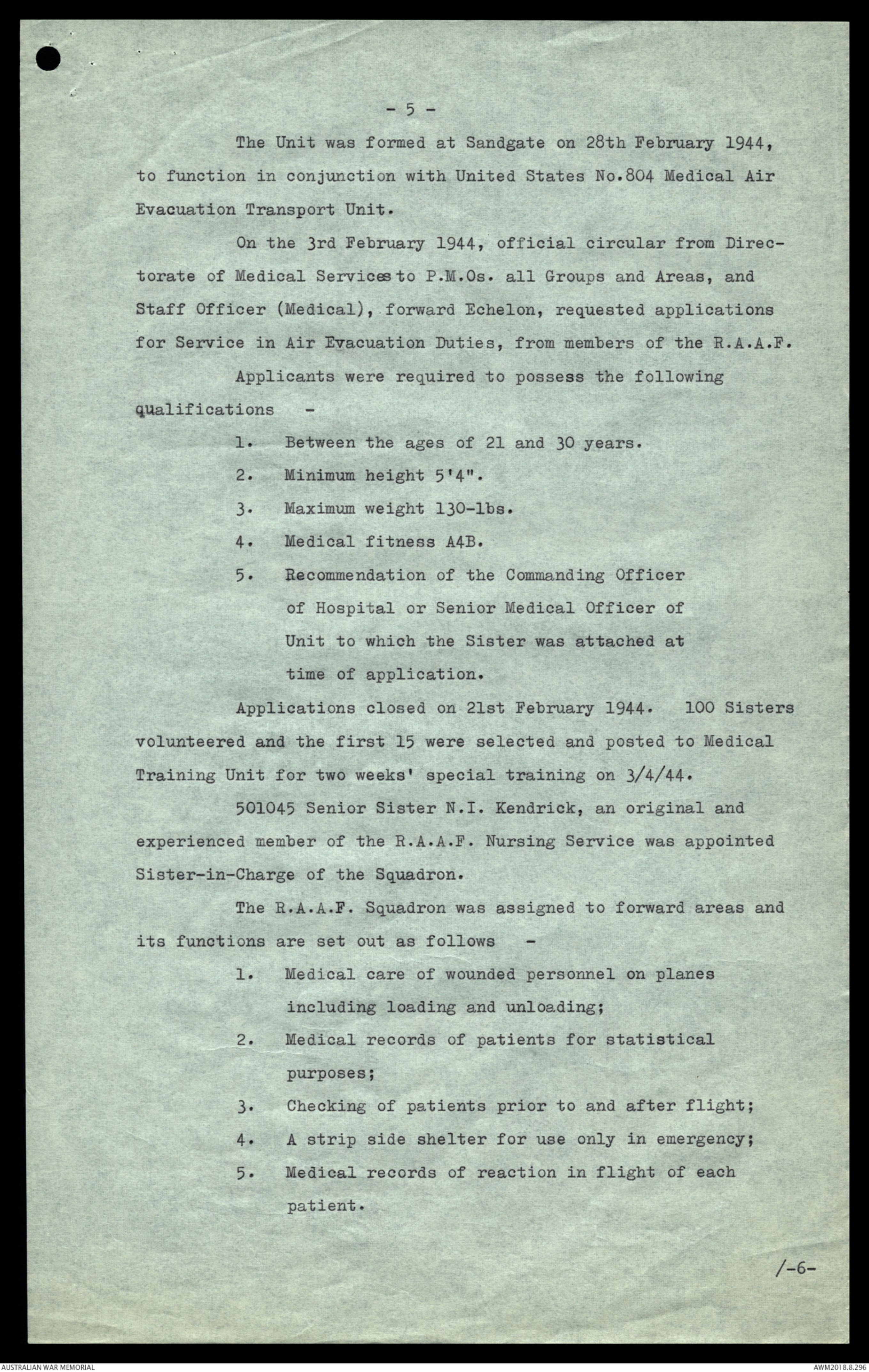
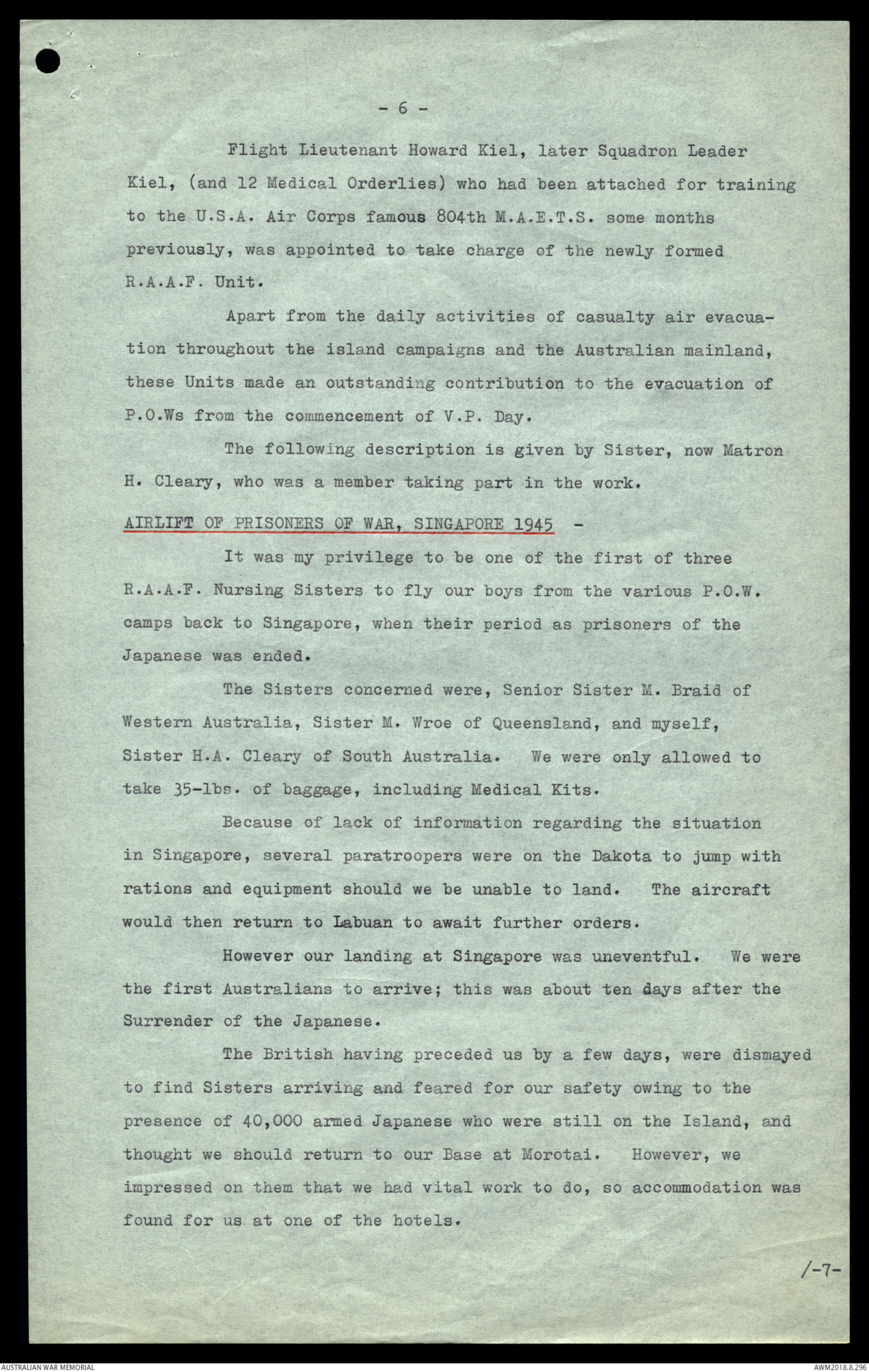
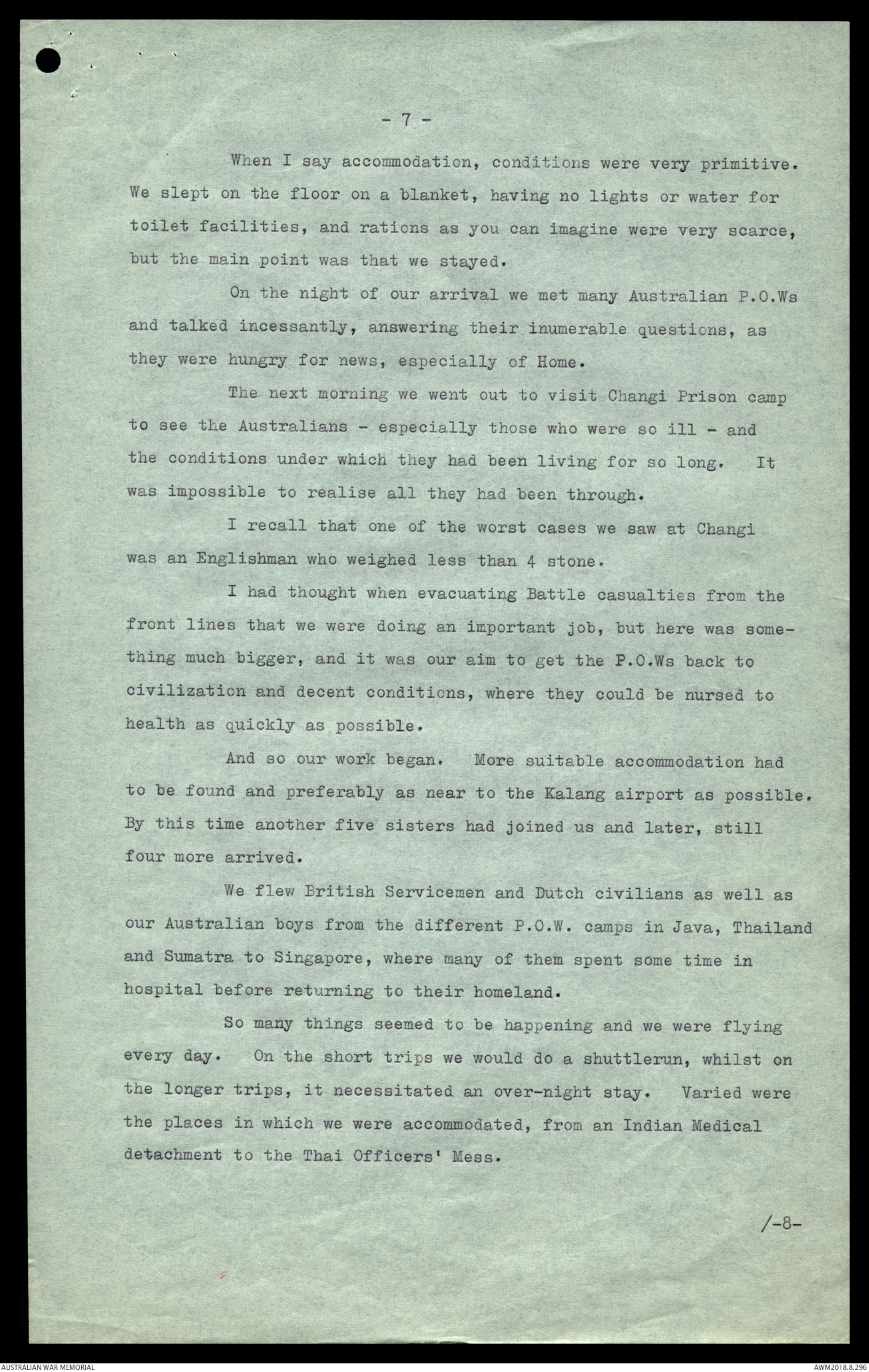

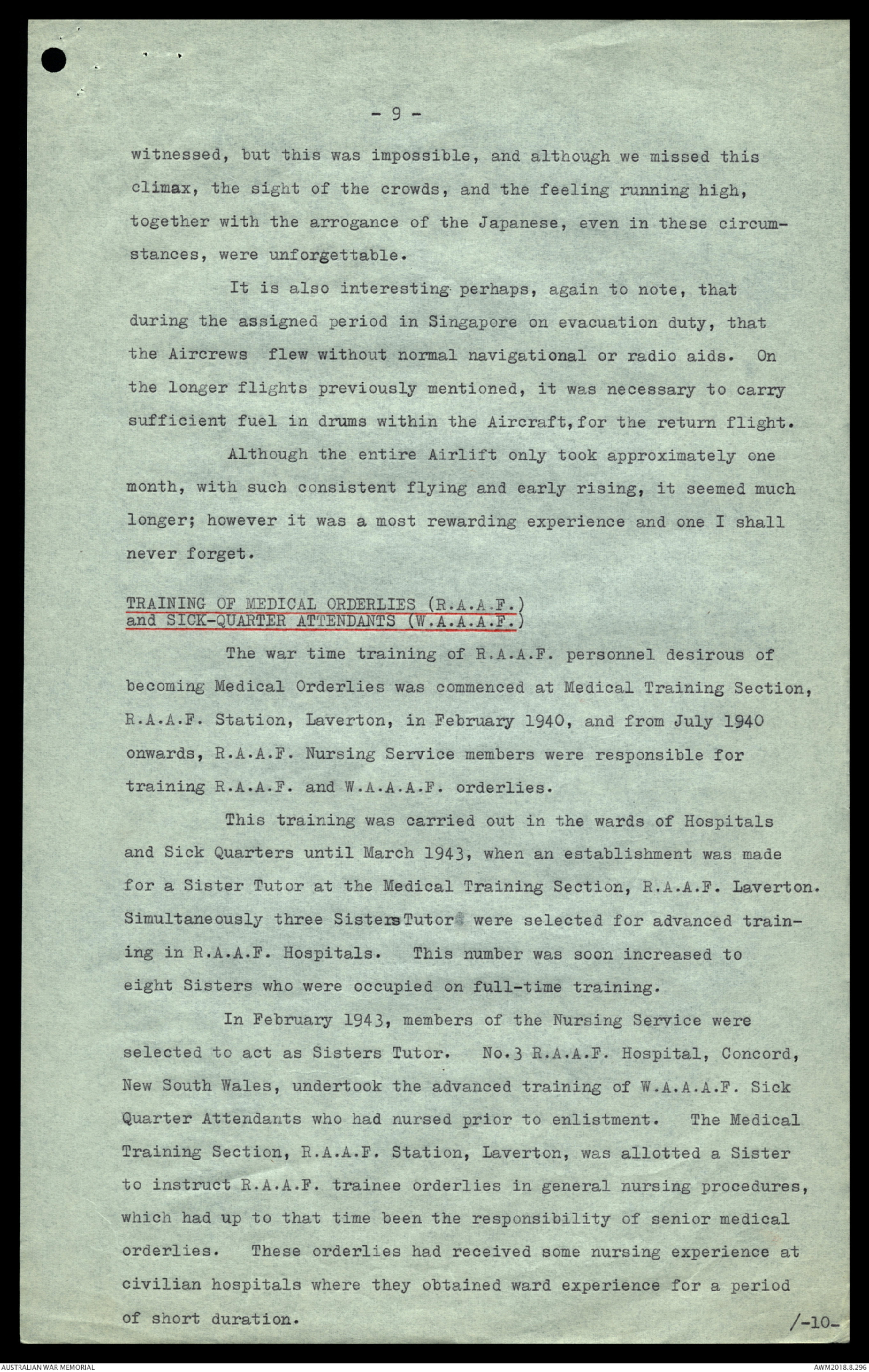
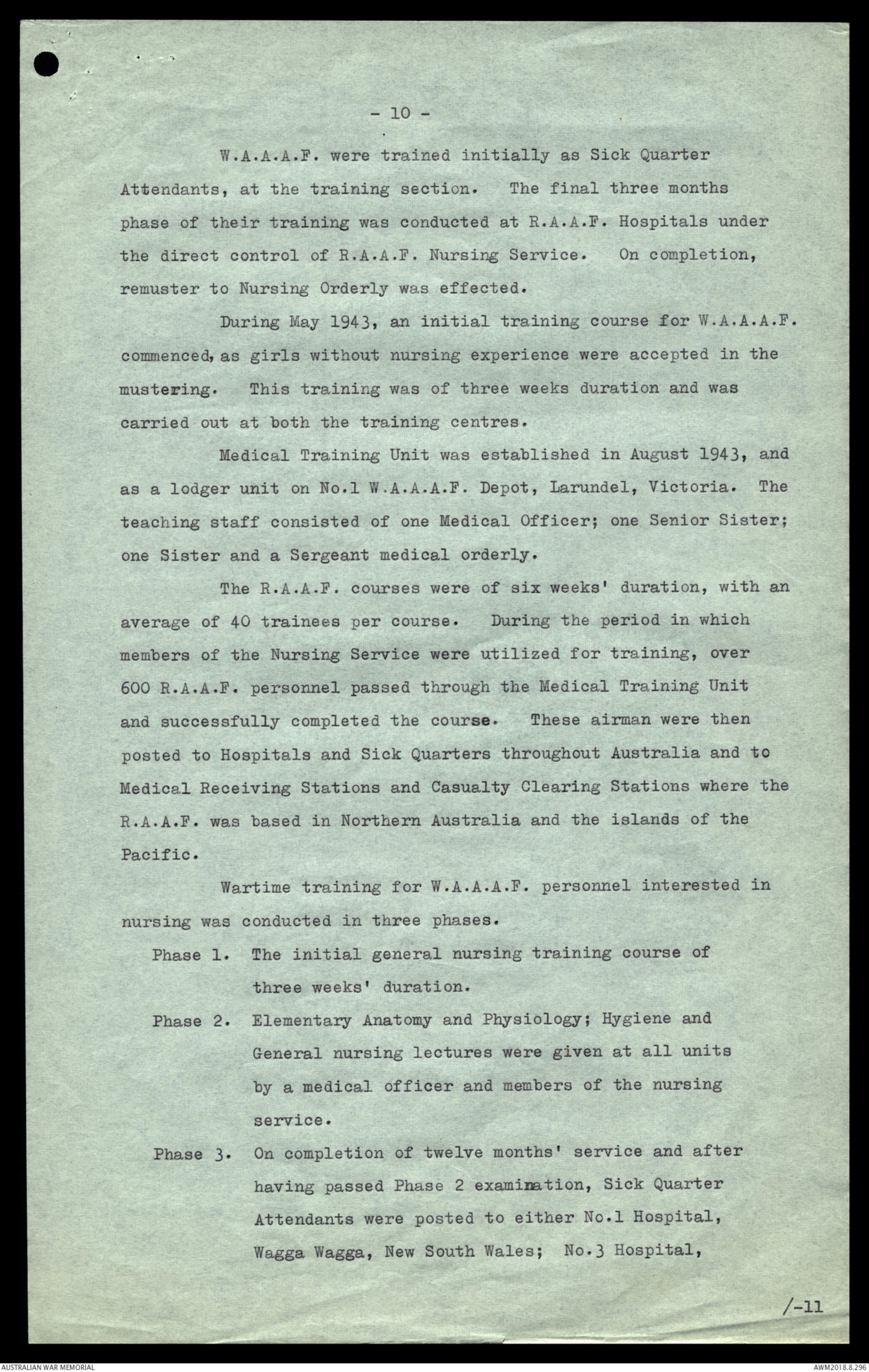
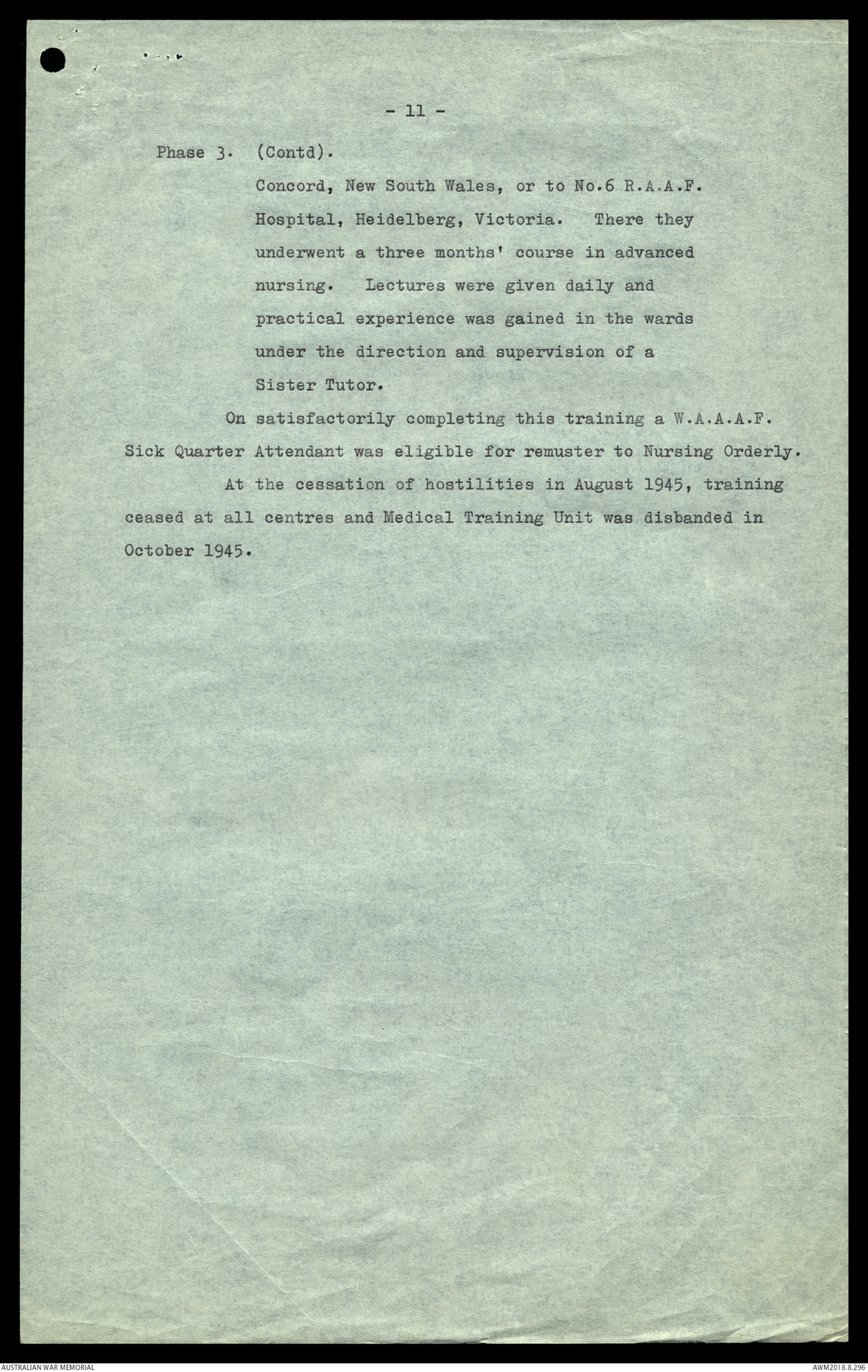

-3-
There was an American Airman very ill with Black Water
Fever, several patients with Dysentery, Dengue and Malaria. The
flies were there in millions.
We firstly attended to patients and secondly we had to
do the washing - there were stacks of soiled linen everywhere.
It could hardly be called washing as there was not an atom of
soap to be had anywhere.
We had an outpatients of 100 when we first arrived, but
it gradually decreased as conditions improved. The keeping of
food was a problem as there was only one Frigidaire for Hospital
patients and Staff. After the first week the Americans delivered
ice daily, their camp being 20 miles away.
Things were very quiet for the patients as there was
nothing there for their welfare until the Red Cross representative
arrived from Alice Springs. √
Primitive living conditions for Nursing Service members
attached to Medical Receiving Stations were unavoidable and for
many months they were under canvas and later in huts. Hot water
was rationed by outside coppers. Nursing Sisters adapted themselves
fairly quickly to tropical conditions but for the first few
weeks Sandfly bites and minor skin conditions were troublesome.
No.1 M.R.S. was situated on the Comali Creek, 60 miles from Darwin -
Surgery was first performed under canvas and later a Mobile Surgical
Unit attached to an air condition theatre. Many serious cases
of 1 first and 2nd degree burns from Aircraft accidents and other
causes made the Nursing duties very heavy; also the larger number
of road accidents involving Special Nursing. Laundry facilities
were poor and on occasions when the Mobile laundry was out of order
the staff had to cope with the laundry. The indoor uniform veils
were hard to maintain in neat condition under the living conditions
that existed. Night duty was trying owing to the difficulty of
sleeping in the heat of the day and seven to ten days' night duty
was found to be the maximum length of night duty possible for
personnel.
/-4-
- 4 -
Diets for sick patients was a problem and the extra
rations of fruit juices and tinned fruit from Red Cross were
invaluable. Primus stoves were used by the Nursing Sister for
the cooking of Special diets and boiling ward sterilizers.
COMMENTS ON NEW GUINEA -
On November 27th 1942, four members of the R.A.A.F.
Nursing Service joined 3 M.R.S. stationed at Port Moresby -
situated in the almost treeles June Valley, besides Ward's Air
strip among the operational Squadrons; the M.R.S. consisted of
tented wards widely dispersed because of the frequent air raids.
The Nursing Service was accommodated in tents. The mosquitoes
were very bad. Anti-malarial clothing was worn and atebrin
taken as ordered. The uniform consisted of long-sleeved shirts
or safari jackets with slacks and gaiters.
Air raids were frequent at this time and the Nursing
Sisters encountered their first raid the second night in New
Guinea. Slit trenches were provided for the patients and staff.
Long hours were worked but the health of the Sisters remained
good. The food was found to be monotonous, although adequate;
later fresh vegetables were grown and most appreciated by patients
and staff.
ESCORT DUTY. -
Between the beginning of October 1940 and the end of
November 1943, 52 members of the R.A.A.F. Nursing Service were
attached to the Medical Staff of official escort parties to R.A.A.F.
personnel proceeding overseas under the Empire Air Training Scheme.
Of the 52 members, 7 were engaged in Medical escort duty from
Australia to the United States, and the other members to Canada
and the United Kingdom.
MEDICAL AIR EVACUATION TRANSPORT UNIT -
On 21/2/44 the Air Board approved of the inauguration
of the above service, with an establishment for R.A.A.F. Medical
Officers, Sisters and Medical Orderlies. Organisation Memorandum 431.
/-5-
-5-
The Unit was formed at Sandgate on 28th February 1944,
to function in conjunction with United States No.804 Medical Air
Evacuation Transport Unit.
On the 3rd February 1944, official circular from Directorate
of Medical Services to P.M.Os. all Groups and Areas, and
Staff Officer (Medical), forward Echelon, requested applications
for Service in Air Evacuation Duties, from members of the R.A.A.F.
Applicants were required to possess the following
qualifications -
1. Between the ages of 21 and 30 years.
2. Minimum height 5'4".
3. Maximum weight 130-lbs.
4. Medical fitness A4B.
5. Recommendation of the Commanding Officer
of Hospital or Senior Medical Officer of
Unit to which the Sister was attached at
time of application.
Applications closed on 21st February 1944. 100 Sisters
volunteered and the first 15 were selected and posted to Medical
Training Unit for two weeks' special training on 3/4/44.
501045 Senior Sister N.I. Kendrick, an original and
experienced member of the R.A.A.F. Nursing Service was appointed
Sister-in-Charge of the Squadron.
The R.A.A.F. Squadron was assigned to forward areas and
its functions are set out as follows -
1. Medical care of wounded personnel on planes
including loading and unloading;
2. Medical records of patients for statistical
purposes;
3. Checking of patients prior to and after flight;
4. A strip side shelter for use only in emergency;
5. Medical records of reaction in flight of each
patient.
/-6-
-6-
Flight Lieutenant Howard Kiel, later Squadron Leader
Kiel, (and 12 Medical Orderlies) who had been attached for training
to the U.S.A. Air Corps famous 804th M.A.E.T.S. some months
previously, was appointed to take charge of the newly formed
R.A.A.F. Unit.
Apart from the daily activities of casualty air evacuation
throughout the island campaigns and the Australian mainland,
these Units made an outstanding contribution to the evacuation of
P.O.Ws from the commencement of V.P. Day.
The following description is given by Sister, now Matron
H. Cleary, who was a member taking part in the work.
AIRLIFT OF PRISONERS OF WAR, SINGAPORE 1945 -
It was my privilege to be one of the first of three
R.A.A.F. Nursing Sisters to fly our boys from the various P.O.W.
camps back to Singapore, when their period as prisoners of the
Japanese was ended.
The Sisters concerned were, Senior Sister M. Braid of
Western Australia, Sister M. Wroe of Queensland, and myself,
Sister H.A. Cleary of South Australia. We were only allowed to
take 35-lbs. of baggage, including Medical Kits.
Because of lack of information regarding the situation
in Singapore, several paratroopers were on the Dakota to jump with
rations and equipment should we be unable to land. The aircraft
would then return to Labuan to await further orders.
However our landing at Singapore was uneventful. We were
the first Australians to arrive; this was about ten days after the
Surrender of the Japanese.
The British having preceded us by a few days, were dismayed
to find Sisters arriving and feared for our safety owing to the
presence of 40,000 armed Japanese who were still on the Island, and
thought we should return to our Base at Morotai. However, we
impressed on them that we had vital work to do, so accommodation was
found for us at one of the hotels.
/-7-
-7-
When I say accommodation, conditions were very primitive.
We slept on the floor on a blanket, having no lights or water for
toilet facilities, and rations as you can imagine were very scarce,
but the main point was that we stayed.
On the night of our arrival we met many Australian P.O.Ws
and talked incessantly, answering their inumerable questions, as
they were hungry for news, especially of Home.
The next morning we went out to visit Changi Prison camp
to see the Australians - especially those who were so ill - and
the conditions under which they had been living for so long. It
was impossible to realise all they had been through.
I recall that one of the worst cases we saw at Changi
was an Englishman who weighed less than 4 stone.
I had thought when evacuating Battle casualties from the
front lines that we were doing an important job, but here was something
much bigger, and it was our aim to get the P.O.Ws back to
civilization and decent conditions, where they could be nursed to
health as quickly as possible.
And so our work began. More suitable accommodation had
to be found and preferably as near to the Kalang airport as possible.
By this time another five sisters had joined us and later, still
four more arrived.
We flew British Servicemen and Dutch civilians as well as
our Australian boys from the different P.O.W. camps in Java, Thailand
and Sumatra to Singapore, where many of them spent some time in
hospital before returning to their homeland.
So many things seemed to be happening and we were flying
every day. On the short trips we would do a shuttlerun, whilst on
the longer trips, it necessitated an over-night stay. Varied were
the places in which we were accommodated, from an Indian Medical
detachment to the Thai Officers' Mess.
/-8-
-8-
The planes were loaded beyond capacity and it is interesting
perhaps, from a statistical point of view, that the Dakota has a
loading capacity of 27 personnel, and we regularly had as many as
46 on board, which did not leave much room for moving around -
but it seemed so hard to leave anyone behind even for only one
more day.
Most of the evacuees were suffering from malnutrition
and dysentry, so the general conditions within the Aircraft can
well be imagined, and practical nursing as we know it, was impossible.
In view of the living and working conditions generally
of the Sisters, it is not surprising that we were prone to very
mixed feelings. We saw so much suffering and worked so constantly,
that to say the least, our task was an arduous one.
This was not helped by the fact that we were unable to
find out any news of the Australian Army Sisters, whom we knew to
be in the area as P.O.Ws. Naturally we seemed to feel much more
deeply where they were concerned, and it was only through the
untiring efforts of one of our crews and a newspaper reporter, that
they were eventually located. This was a month after the surrender.
It was wonderful to see them and I shall never forget how excited
they were.
There is one other aspect of my stay in Singapore that
stands out in my memory. It was the formal signing of the surrender.
Thousands of the Asiatic population lined the streets for miles
en route to the Building. Allied Servicemen who had arrived since
the surrender were most spectacular in their different uniforms,
and of course, the Air Forces of the Allies were in evidence over
the area, flying in formation displays, during the actual signing
of the document.
After the arrival of Lord Louis Mountbatten and party,
six high ranking Japanese officers were brought forward and taken
into the building and ceremoniously stripped of their swords.
Truly a moving moment and one we would naturally like to have
/-9-
-9-
witnessed, but this was impossible, and although we missed this
climax, the sight of the crowds, and the feeling running high,
together with the arrogance of the Japanese, even in these circumstances,
were unforgettable.
It is also interesting perhaps, again to note, that
during the assigned period in Singapore on evacuation duty, that
the Aircrews flew without normal navigational or radio aids. On
the longer flights previously mentioned, it was necessary to carry
sufficient fuel in drums within the Aircraft, for the return flight.
Although the entire Airlift only took approximately one
month, with such consistent flying and early rising, it seemed much
longer; however it was a most rewarding experience and one I shall
never forget.
TRAINING OF MEDICAL ORDERLIES (R.A.A.F.)
and SICK-QUARTER ATTENDANTS (W.A.A.A.F.)
The war time training of R.A.A.F. personnel desirous of
becoming Medical Orderlies was commenced at Medical Training Section,
R.A.A.F. Station, Laverton, in February 1940, and from July 1940
onwards, R.A.A.F. Nursing Service members were responsible for
training R.A.A.F. and W.A.A.A.F. orderlies.
This training was carried out in the wards of Hospitals
and Sick Quarters until March 1943, when an establishment was made
for a Sister Tutor at the Medical Training Section, R.A.A.F. Laverton.
Simultaneously three Sisters Tutor were selected for advanced training
in R.A.A.F. Hospitals. This number was soon increased to
eight Sisters who were occupied on full-time training.
In February 1943, members of the Nursing Service were
selected to act as Sisters Tutor. No.3 R.A.A.F. Hospital, Concord,
New South Wales, undertook the advanced training of W.A.A.A.F. Sick
Quarter Attendants who had nursed prior to enlistment. The Medical
Training Section, R.A.A.F. Station, Laverton, was allotted a Sister
to instruct R.A.A.F. trainee orderlies in general nursing procedures,
which had up to that time been the responsibility of senior medical
orderlies. These orderlies had received some nursing experience at
civilian hospitals where they obtained ward experience for a period
of short duration.
/-10-
-10-
W.A.A.A.F. were trained initially as Sick Quarter
Attendants, at the training section. The final three months
phase of their training was conducted at R.A.A.F. Hospitals under
the direct control of R.A.A.F. Nursing Service. On completion,
remuster to Nursing Orderly was effected.
During May 1943, an initial training course for W.A.A.A.F
commenced, as girls without nursing experience were accepted in the
mustering. This training was of three weeks duration and was
carried out at both the training centres.
Medical Training Unit was established in August 1943, and
as a lodger unit on No.1 W.A.A.A.F. Depot, Larundel, Victoria. The
teaching staff consisted of one Medical Officer; one Senior Sister;
one Sister and a Sergeant medical orderly.
The R.A.A.F. courses were of six weeks' duration, with an
average of 40 trainees per course. During the period in which
members of the Nursing Service were utilized for training, over
600 R.A.A.F. personnel passed through the Medical Training Unit
and successfully completed the course. These airman were then
posted to Hospitals and Sick Quarters throughout Australia and to
Medical Receiving Stations and Casualty Clearing Stations where the
R.A.A.F. was based in Northern Australia and the islands of the
Pacific.
Wartime training for W.A.A.A.F. personnel interested in
nursing was conducted in three phases.
Phase 1. The initial general nursing training course of
three weeks' duration.
Phase 2. Elementary Anatomy and Physiology; Hygiene and
General nursing lectures were given at all units
by a medical officer and members of the nursing
service.
Phase 3. On completion of twelve months' service and after
having passed Phase 2 examination, Sick Quarter
Attendants were posted to either No.1 Hospital,
Wagga Wagga, New South Wales; No.3 Hospital,
/-11
-11-
Phase 3. (Contd).
Concord, New South Wales, or to No.6 R.A.A.F.
Hospital, Heidelberg, Victoria. There they
underwent a three months' course in advanced
nursing. Lectures were given daily and
practical experience was gained in the wards
under the direction and supervision of a
Sister Tutor.
On satisfactorily completing this training a W.A.A.A.F.
Sick Quarter Attendant was eligible for remuster to Nursing Orderly.
At the cessation of hostilities in August 1945, training
ceased at all centres and Medical Training Unit was disbanded in
October 1945.
R.A.A.F NURSING SERVICE
The R.A.A.F. Nursing Service was modelled on the
Princess Mary's Royal Air Force Nursing Service, with conditions,
and rates of pay, similar to those of the A.A.N.S.
It was established no 26th July, 1940. Before that
date, members were nursed by medical orderlies, or by civilian
nurses, and Repatriation Department.
Early in 1940, Group Captain Daley, now our FORMER Director
General of Medical Services, advocated, and obtained, the
continuous employment of civilian nurses.X In April, 1940,
sixteen civilian Sisters were employed - four at Laverton,
two at Point Cook, five at Ascot Vale, and five at Richmond.
Later, their numbers were increased.
With the rapid expansion of the Air Force, the services
of the civilian nurses proved inadequate, and it was realised
that a R.A.A.F. Nursing Service was essential within the Air Force.
In addition to the advantages which the R.A.A.F. sick would gain
from their high professional standard of attention, nurses could
be used also for the instruction of R.A.A.F. Nursing Orderlies,
and so increase the latter's efficiency. The appointment of
Tutor Sisters at a Medical Training Unit raised the standard
of the Medical Orderlies to a high level.
In June, 1940, Air Commodore Hurley recommended to
the Air Member for Personnel that a R.A.A.F. Nursing Service
be formed, and, in the same month, the recommendation was approved
by the Minister for Air.
Miss M.I. Lang, who had served in the First World War,
was appointed Matron-in-Chief. She was posted to R.A.A.F.
Headquarters in the Directorate of Medical Services, on the staff
of the Director General of Medical Services. Her functions were
to direct and supervise the Nursing Service, and to advise
Director General of Medical Services on all nursing in hospitals
and sick quarters; and the appointment, posting, attachment,
promotion, and discharge, of R.A.A.F. Nurses. She was to be
represented by Principal Nursing Officers in each State of the
Commonwealth, and in all R.A.A.F. areas.
Later, Miss Lang was awarded the O.B.E. for her
wonderful contribution, and organisation of the R.A.A.F. Nursing
Service.
Miss M.K. Doherty was appointed Principal Nursing Officer
of No.2 Training Group, and was responsible for all Nursing matters
in New South Wales. Her contribution to the training of Medical
Orderlies was outstanding, and her Text Book - Modern Practical
Nursing Procedures (Doherty, Sirl, Ring) - is still used in many
of the modern Training Hospitals today. and in the RAAF
Miss Doherty was released from the Service at the end
of the War to join UNRRA, and was appointed Matron of Belsen
in Germany.
Miss Doherty was awarded the Royal Red Cross for her
devotion to duty in the R.A.A.F.
.../2
 Not Yet Replaced By AI
Not Yet Replaced By AIThis transcription item is now locked to you for editing. To release the lock either Save your changes or Cancel.
This lock will be automatically released after 60 minutes of inactivity.